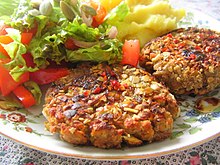It may have been about 20 years ago that we were told to eat a low fat diet for our overall health, especially our heart health. So, being someone who wants to be healthy, hence the name of the blog, of course I wanted to make sure that my family was fed the lowest fat diet. We had low fat cheese, low fat sauces, cakes, cookies and on an on. I stopped using butter because that was too high in fat. Eggs, well you could only use the whites because the yolk was pure cholesterol! We went for years eating this way. I even went so far as to completely cut some foods out of our diet because they were too high in fat. Nuts being one of them.
Except for peanuts all other nuts were off limits. Somehow, peanuts were okay. Although still high in fat, peanuts were from the ground so they were better for us. With all this confusing information I finally said enough. I took it upon myself to find out what should we really eat?
With the help of my daughter, who learned about veganism*. (no not some form of weird cult group) and my brother, who had been a vegan before the word was coined I think, I went about finding out as much as I could about food.
*According to Wikipedia a vegan is:
From Wikipedia, the free encyclopedia
"Vegan" redirects here. For other uses, see Vegan (disambiguation).
Veganism is a philosophy and lifestyle whose adherents seek to exclude the use of animals for food, clothing, or any other purpose.[1][2]Vegans endeavor not to use or consume animal products of any kind.[3] The most common reasons for becoming a vegan are human health, ethical commitment or moral conviction concerning animal rights or welfare, the environment, and spiritual or religious concerns.[2][4][5] Of particular concern to many vegans are the practices involved in factory farming and animal testing, and the intensive use of land and other resources for animal farming.
Properly planned vegan diets are healthful and have been found to satisfy nutritional needs, and offer protection against heart disease, cancer, and other diseases.[6][7]
Once my daughter related the information she had learned about a vegan diet, I started to look into the information further. Not only did I find out that nuts were good for you, but there was a plethora of foods that I could eat without guilt. Oh to enjoy the taste of food again! But will this new information soon be found to be unhealthy as well? Does anyone really know what the "right" or "healthy" diet is for today? Suffice it to say that any diet with pure fruits, vegetables, legumes and NUTS, can't be bad for you!
Growing up, my mom would always have a bowl of nuts on the table. After dinner, especially on holidays, everyone would sit at the table and talk as they cracked open the nuts. It was a family ritual that we all knew and looked forward to after the meal. It also kept us all at the table as we listened to family conversation, stories, and jokes. Then, all of a sudden, the nuts were no longer at the table! Word spread that nuts were bad for you. Among other foods, nuts were on the outs. No matter where you went, if nuts were included in the meal they were left on the side.
As we moved into the 21st century, the information gathered was changed and re-evaluated. Thank goodness someone has the sense to get the word out before we all continued on that tasteless road of bland, fat free food for life! I, for one, am grateful to my daughter and my brother for opening my eyes to another way of enjoying my food and learning that there is more to health than fat free.
Today, it's comforting to know that nuts are back on the table and a part of the meal again! So go enjoy those nuts and maybe a few conversations around the table while cracking some of those nuts as well!



